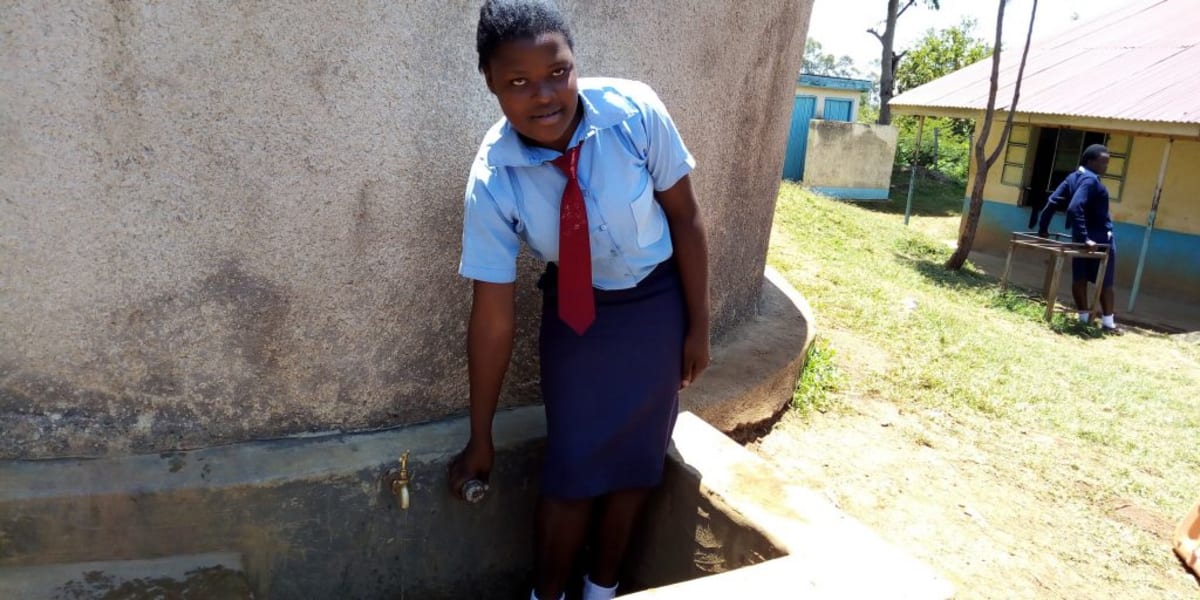Esibeye Secondary School was founded in 2007 by a church that donated its land. The school now has an enrollment of 426 students who are taught by 18 teachers. The school also employs eight support staff.
Students get up very early in the morning to get ready and walk to school. Their lessons begin with study hall at 7am. With a break for announcements and lunch, students finally end the day with games. This school is located in a very quiet area with a fair road network that makes accessibility easier.
Water
All the school has for water is a 5,000-liter plastic tank. This can catch rainwater, but it is not nearly enough for the growing student and teacher population.
When the tank hasn't received fresh rain, it runs dry quickly. Students must go out into the community to bring back enough water to keep things running. Water fetched by students is used for drinking, cooking, and cleaning. Students report that they most often walk to a particular protected spring in the community. However, administration is concerned that water could be contaminated by the time the it is carried back to school.
This coupled with poor hygiene and sanitation could be why typhoid and cholera keep students out of school.
Sanitation
The latrines for students filled up entirely and had to be torn down. Students are now walking to the nearby primary students to share their latrines.
There are still useable latrines remaining for teachers and other staff. The school has two hand-washing stations they built on their own, which are used by both teachers and students. However, they don't have any soap.
Principal Fredrick Kubai said, "Our school is now at a very critical moment, especially after our only eight doors of latrines were collapsed, forcing our students to cross over to the primary section as the only option. Looking at the population of my 426 students, I am worried if the primary section will be able to accommodate this number given that they have also a higher population of about 700 pupils compared to the available facilities. I thank God that you people have come at the time when we really need support!"
Training
Training will be held for two days. The facilitator will use PHAST (participatory hygiene and sanitation transformation), ABCD (asset-based community development), CTC (child to child), lectures, group discussions, and handouts to teach health topics and ways to promote good practices within the school. The CTC method will prepare students to lead other students into healthy habits, as well as kickstart a CTC club for the school.
Hand-Washing Stations
This CTC club will oversee the new facilities, such as hand-washing stations, and make sure they are kept clean and in working condition. The two hand-washing stations will be delivered to the school, and the club will fill them with water on a daily basis and make sure there is always a cleaning agent such as soap or ash.
VIP Latrines
Two triple-door latrines will be constructed with local materials that the school will help gather. Three doors will serve the girls while the other three serve the boys. And with a new source of water on school grounds, students and staff should have enough to keep these new latrines clean.
Rainwater Catchment Tank
A 50,000-liter rainwater catchment tank will help alleviate the water crisis at this school. The school will also help gather the needed materials such as sand, rocks, and water from the spring for mixing cement. Once finished, this tank can begin catching rainfall that will be used by the school’s students and staff. Students will no longer have their school days interrupted for fetching water.
There will be enough clean water for drinking, cooking, and cleaning. We and the school strongly believe that with this assistance, standards will significantly improve. These higher standards will translate to better academic performance!
This project is a part of our shared program with Western Water And Sanitation Forum (WEWASAFO). Our team is pleased to provide the reports for this project (edited for readability) thanks to the hard work of our friends in Kenya.

 Rainwater Catchment
Rainwater Catchment
 Rehabilitation Project
Rehabilitation Project




































